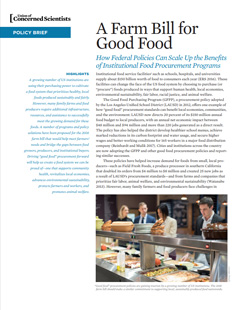One of the most promising developments on the US food landscape is the rise of "good food" procurement policies at public institutions such as schools, hospitals, and universities. Through the standards they set for their food suppliers, these institutions are turning their food budgets into powerful tools to move our food system in a healthier, fairer, more sustainable direction.
As we found in our 2017 report Purchasing Power, good food procurement policies in cities such as Los Angeles are already producing positive results: healthier food for children, expanded markets for local farmers, better wages and working conditions for food workers, more environmentally friendly farming, and more humane treatment of animals. As producers shift their practices to comply with the new standards, these policies create ripple effects that extend far beyond the specific communities they serve. And their successes are sparking similar efforts elsewhere.
However, change is not easy. Food producers trying to meet good food program requirements face many challenges, which public policy can help overcome. Enter the farm bill—the legislation that shapes federal food and farm policy. The farm bill offers opportunities to invest in programs and infrastructure that can help community institutions deliver on the promise of "good food."
Our policy brief, A Farm Bill for Good Food, identifies key provisions from three bills that have been introduced to shape the 2018 farm bill debate: the Beginning Farmer and Rancher Opportunity Act (H.R. 4316), the Food and Farm Act (H.R. 4425), and the Local Food and Regional Market Supply (FARMS) Act (S. 1947/H.R. 3941). These provisions are critical to driving good food procurement forward and allowing communities across the country to reap the benefits.




